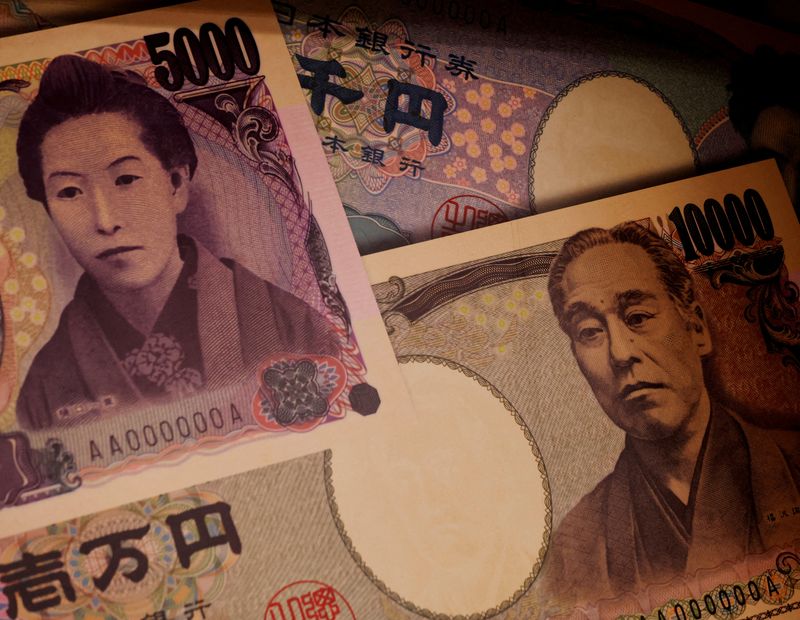
By Amanda Cooper and Brigid Riley
LONDON/TOKYO (Reuters) – Japanese official buying to defend the yen is fast becoming a standard feature of the FX landscape in 2024, but authorities in Tokyo have switched up their methods, making it even trickier for investors to second-guess when and how they might step in.
The novel intervention tactics may have wrongfooted traders enough to help Japan’s financial authorities turn the tide on their currency, which hit its weakest against the dollar since 1986 just four weeks ago.
The Bank of Japan, at the Ministry of Finance’s behest, likely spent nearly 6 trillion yen ($38.4 billion) this month in shoring up the yen.
As the dollar traded at 38-year highs around 160 yen two weeks ago, authorities in Tokyo warned almost daily they would step in should volatility prove excessive or the level of the Japanese currency not reflect the underlying economic and monetary-policy reality. Another round of intervention was, therefore, hardly a surprise.
There has been no official confirmation of intervention, but when the first round of a one-two punch arrived on July 11, traders believe the BOJ pounced on weak U.S. inflation data that hit the dollar – selling dollars into the slide in the U.S. currency, rather than into weakness in the yen.
The dollar/yen pair, which is now below 155 yen, dropped in minutes to around 158.3 from 161, immediately raising suspicion among traders of intervention.
“It appears the MOF and BOJ may have turned ‘momentum trader’, grabbing their moment to hit the market when it was at its most vulnerable,” Chris Weston, market strategist at Pepperstone said at the time.
Typically, the BOJ would step in when U.S. Treasury yields and the dollar were rising.
“This time wasn’t like that. In fact, it was during a sell-off of the dollar, which caused dollar/yen to drop, that we saw this unusual shift in the yen,” Hiroyuki Machida, director of Japan FX and commodities sales at ANZ, said.
“Assuming that the dramatic and abrupt movement of the yen over a short span of time was a result of intervention, then it was indeed unlike patterns we’ve seen in the past,” Machida said.
A second round of suspected official buying on July 12 made investors nervous enough that another rally in the yen on July 15 was initially pinned on intervention that market data subsequently showed had most likely not taken place.
Bank of America, which has argued for some time that the BOJ could opt for routine intervention, like the Swiss National Bank, say Japanese authorities may have had three aims in mind: maximising the impact, upping the element of surprise and warding off any excess speculative moves.
JOB DONE?
It seems to have worked. The yen has strengthened by almost 4% this month and options positioning is starting to shift.
Traders are less confident than they have been for some time that the yen is on a one-way street to more weakness.
The derivatives market shows the premium in the price of options to buy the yen in one month’s time is growing relative to the price of sell options – an indication that traders are turning more bullish.
The principal driver of the 30% drop in the yen in the last four years has been the discount in interest rates in Japan to those elsewhere, but, most notably, in the United States.
The BOJ meets on July 31 to set monetary policy and a very mixed bag of economic data means the chances of a hike from 0.1% are about 50/50.
The Federal Reserve, meanwhile, is all but certain to cut rates by a quarter point when it meets in September to a range of 5.00-5.25%.
MUFG FX strategist Lee Hardman said July’s moves in the currency “suggest a change in strategy from Japan to be more proactive rather than reactive when providing support for the yen.”
Speculators still hold one of the biggest bets against the yen on record. At nearly $12 billion, it has more than doubled since the start of 2024 alone.
ANZ’s Machida said with a bearish position of this size, the prospect of more unpredictable intervention was “terrifying.”

“It’s incredibly painful. You might have been sitting pretty, thinking you’d made a profit at 161 yen, but now it’s at 156 yen. If the Bank of Japan were to step in at this level, at 156 yen, you’d probably just want to throw in the towel.”
($1 = 156.1000 yen)
This post is originally published on INVESTING.


